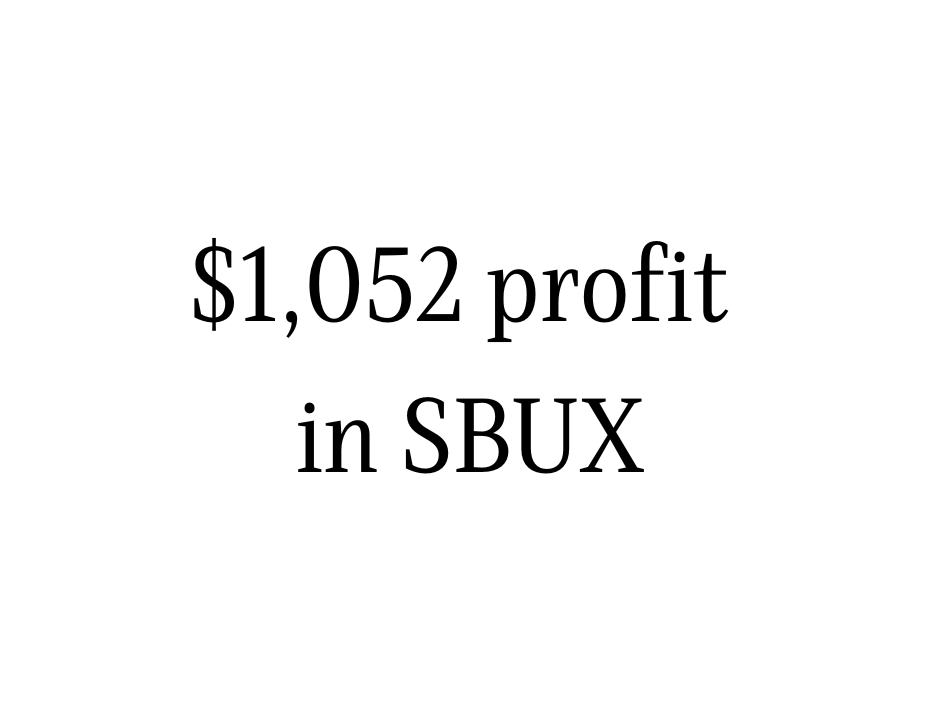Using options to complement long-term stock positions
- themoneyloaf
- Oct 23
- 3 min read
Happy weekend!
This week I wanted to share something a little different: how selling options complements long-term buy and hold positions, and how using options can actively lower your cost basis in any stock or ETF holding.
As you may know, my main focus is on cash flow, so being able to lower the cost basis of any dividend stock directly means I'm getting a better dividend yield, because I'm getting paid the same amount, but at a lower price.
Also a reminder that I'm opening up the form to register your interest in my first options course of 2026. I have a simple FAQ page here if you'd like to know more information in advance.
This week:
Using options to complement a long-term stock position
The 5 year return of SBUX
SBUX has been a pretty terrible investment over the last 5 years - down about 3.5%.
Looking at the chart below, it's clear that anyone who bought SBUX over the last 5 years is likely sitting on unrealized loss right now.
Now, this in itself is not a bad thing - lower prices means being able to buy more or reinvest dividends at a lower price, and hopefully enjoy a jump later. \
I personally bought 100 shares of SBUX at $100 per share, which means technically I should be down about $1,500.
Instead I'm up over $6,000. How? By using options.

Even though I got assigned 100 shares of SBUX at $100, I have been selling all sorts of options before and after buying the shares, to generate income. Here's the numbers for the last 5 years:
2021: $709 realized profit from 10 trades
2022: $468 realized profit from 2 trades
2023: $1,725 realized profit from 18 trades
2024: $2,035 realized profit from 9 trades
2022: $1,668 realized profit from 14 trades (with 1 trade still open)
That's a total of $6,605 realized profit which directly goes towards lowering my cost basis in SBUX.
On top of that, I asked Gemini to estimate how much I would have brought in from SBUX over this period, and I'll take the low end of the estimate: $1,180.

So that's $6,605 realized profit from options and $1,180 from dividends, a total of $7,785.
This means that my effective cost basis per share is actually ($10,000 - $7,785)/100 shares, or $22.15.
Even though SBUX's return over the last 5 years has been pretty bad, by layering an option strategy over it, I'm still coming out ahead. As I make more profits from options and dividends, eventually I'll completely cover the initial $10,000 spent to purchase the stock.
Apply this method to every stock and ETF in one's portfolio, and you can see how this better positions your holdings for the long term.
While the focus of this newsletter has been on individual winning trades, I wanted to also share how each trade comes together to support my overall investing and wealth-building as a whole.
Individual wins are nice, but it's also important to know where what the system is building towards.
As always all the trades within this portfolio are updated in close to real-time to my private community (not recommendations). While I do share my own profit targets, they can of course be adjusted to meet your own risk profile as well.
You can find out more about my private community at the link below.
Worries about banks pushed the VIX back above 20. Coupled with earnings next week, there could be some opportunities for the portfolio - fingers crossed!
Have a good weekend!
Free mini course: Kickstart your personal finances in 5 weeks
Latest Youtube video: comparing my 8 income streams in 2023 vs 2022
Improve your financial life with my budget and wealth tracker that helps to allocate your budget, calculate savings rate, track your sinking funds, net worth and progresses towards FIRE with minimal input from you - most of it is automated.
Sign up for real time updates (not recommendations) within my portfolio with the Bread Crumb subscription
This article is for educational purposes only. This is my own portfolio which is being managed according to my goals and risk tolerance. Your situation is likely different and you should do your own due diligence before investing in stocks or options.



Comments